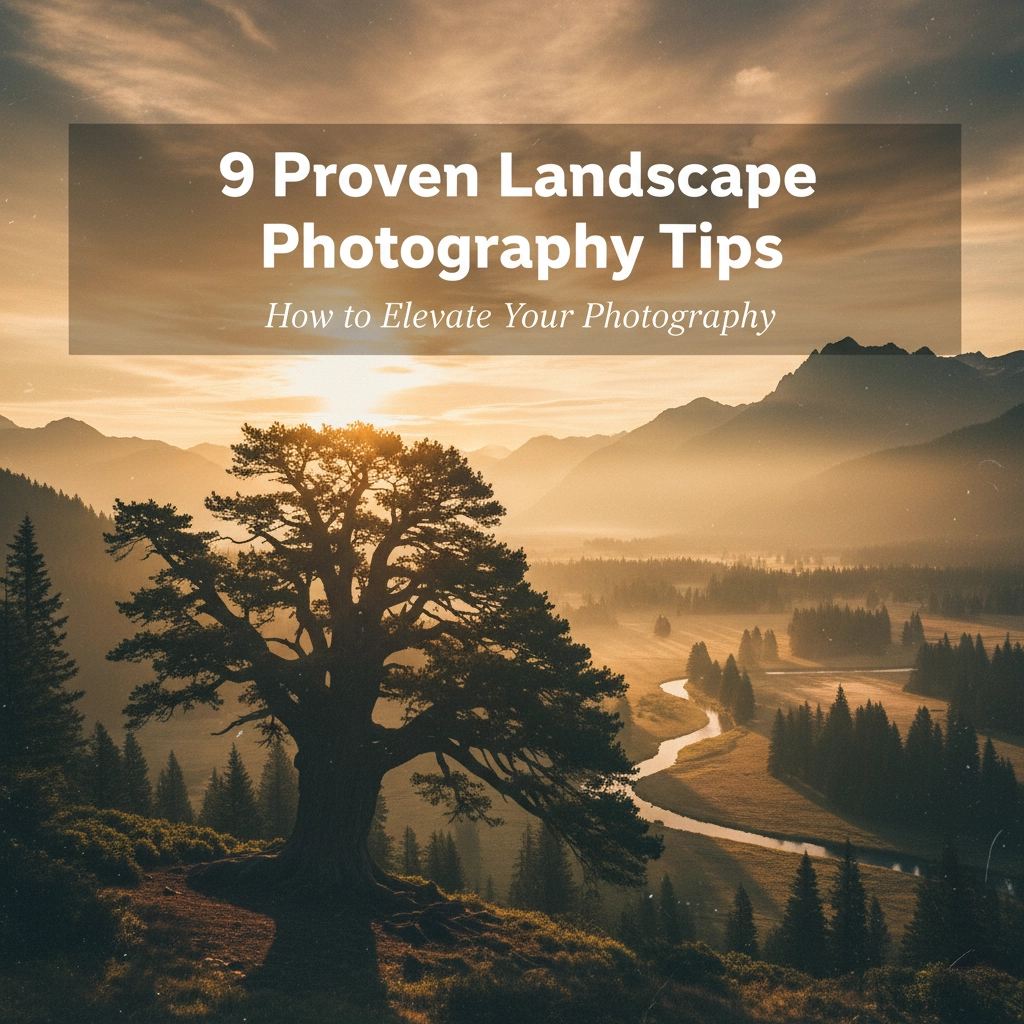
9 Proven Landscape Photography Tips – How to Elevate Your Photography
Landscape photography is an art that transcends capturing mere images; it’s about freezing moments in time, preserving the grandeur of nature. Whether you’re a seasoned photographer or just starting, mastering landscape photography requires a blend of skill, creativity, and an understanding of your surroundings. Here’s my 9 Landscape Photography Tips.

The Magic of Golden Hour
One of the key secrets to breathtaking landscape shots is harnessing the magic of the golden hour. As the sun gently kisses the horizon during sunrise and sunset, it casts a warm, soft glow, creating a mesmerising atmosphere. Pro Tip: Begin your shooting sessions during these hours for ethereal landscapes.
Choosing the Right Equipment
Investing in the right equipment can make or break your landscape photography endeavors. A sturdy tripod, wide-angle lens, and quality camera are your essential companions. Must-Have Gear: Opt for a lens with a focal length between 16mm and 35mm for expansive vistas.
Composition is Key
Great composition is the heart of compelling landscape photography. Experiment with the rule of thirds, leading lines, and framing to create visually striking photographs. Crafting the Perfect Shot: Place key elements like mountains or trees along the grid lines to enhance visual appeal.
Understanding Light and Shadows

Mastering the interplay of light and shadows is pivotal in landscape photography. Be attentive to how sunlight interacts with your surroundings, creating depth and contrast. Play with Shadows: Experiment with the dynamic range of your camera to capture intricate details in both highlights and shadows.
The Art of Long Exposure
Long exposure photography adds a touch of magic to landscapes. Smooth out water surfaces, capture star trails, and create dreamlike effects with this technique. Setting the Scene: Use a neutral density filter to achieve longer exposure times and unleash your creativity.
Embrace Weather Variations
Don’t let unpredictable weather discourage you. Embrace changing conditions, as they often lead to unique and dramatic shots. Rain, mist, or snow can add a captivating dimension to your landscapes . Bold Choices: Capture stormy skies or fog-covered landscapes for moody and captivating images.
Post-Processing Finesse
Once you’ve captured your masterpiece, post-processing is where the magic happens. Fine-tune colours, contrast, and sharpness to bring out the full potential of your images. Editing Essentials: Experiment with software like Adobe Lightroom to enhance the vibrancy and clarity of your landscapes.
Location Scouting Wisdom
Choosing the right location is a great scenery photography tip as crucial as mastering your camera settings. Scout locations beforehand, considering elements like terrain, lighting, and accessibility. Scouting Checklist: Look for foreground interest, varied textures, and captivating backdrops to elevate your compositions.
Patience, Patience, Patience
Landscape photography is a dance with nature, and patience is your greatest ally. Wait for the perfect moment, whether it’s the right light, weather conditions, or the convergence of elements that create photographic magic. Timing Matters: Patience rewards you with shots that tell a story and evoke emotions.
Landscape Photography Tips Conclusion
Mastering landscape photography techniques is a continuous journey of exploration and refinement. Each shot is an opportunity to learn and grow as a photographer. Embrace the challenges, experiment with techniques, and let your creativity soar. As you apply these ten essential tips, you’ll find yourself capturing landscapes that not only reflect the beauty of nature but also showcase your unique perspective as an artist.
Frequently Asked Questions (FAQ)
Q1: How can I deal with challenging weather conditions during a photo shoot?
A: Embrace the challenge! Adverse weather conditions often lead to unique and dramatic shots. Experiment with different settings on your camera and use weather to your advantage, adding an extra layer of intrigue to your landscapes.
Q2: Is post-processing necessary for landscape photography?
A: While it’s not mandatory, post-processing allows you to enhance and fine-tune your images. Software like Adobe Lightroom provides powerful tools to bring out the full potential of your landscapes, emphasising colours, contrast, and sharpness.
Q3: What role does location scouting play in landscape photography?
A: Location scouting is paramount. Visit potential shooting locations beforehand to assess terrain, lighting conditions, and accessibility. Look for elements like captivating backdrops and foreground interest to elevate the overall composition of your photographs.
Q4: Why is the golden hour essential for landscape photography?
A: The golden hour, occurring during sunrise and sunset, bathes the landscape in a warm, soft glow. This magical light adds depth and beauty to your images, creating a captivating atmosphere that enhances the overall visual appeal.
Q5: Can I capture stunning landscapes with basic equipment?
A: While specialised gear can enhance your photography, basic equipment can still yield stunning results. Focus on composition, lighting, and technique to make the most of what you have. As your skills grow, consider expanding your equipment for more creative possibilities.
Like what you read? Fuel my next post with a coffee – hit that PayPal button and keep the caffeine flowing!
[wpedon id=77]